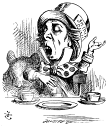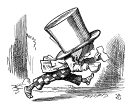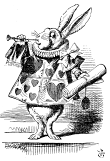Search us!
Search The Word Detective and our family of websites:
This is the easiest way to find a column on a particular word or phrase.
To search for a specific phrase, put it between quotation marks. (note: JavaScript must be turned on in your browser to view results.)
Ask a Question! Puzzled by Posh?
Confounded by Cattycorner?
Baffled by Balderdash?
Flummoxed by Flabbergast?
Perplexed by Pandemonium?
Nonplussed by... Nonplussed?
Annoyed by Alliteration?

Don't be shy!
Send in your question!
Columns from 1995 to 2006 are slowly being added to the above archives. For the moment, they can best be found by using the Search box at the top of this column.
 If you would like to be notified when each monthly update is posted here, sign up for our free email notification list.
If you would like to be notified when each monthly update is posted here, sign up for our free email notification list.
Trivia
All contents herein (except the illustrations, which are in the public domain) are Copyright © 1995-2020 Evan Morris & Kathy Wollard. Reproduction without written permission is prohibited, with the exception that teachers in public schools may duplicate and distribute the material here for classroom use.
Any typos found are yours to keep.
And remember, kids,
Semper Ubi Sub Ubi
|
Among the nebulons.
I was writing a column recently on the term “ne’er-do-well,” meaning a worthless or disreputable person, when I remembered that every entry in the Oxford English Dictionary Online (www.oed.com) has a link to the OED Historical Thesaurus (OEDHT) entry for that particular word. The Historical Thesaurus, which was completed in 2009 after 44 years of work, is the largest thesaurus in the world, and the online version links every synonym of a word to the synonym’s entry in the OED. It sounds complicated, but using it is very easy, endlessly fascinating and weirdly addictive. The OED Online, which includes the OEDHT, is available through many public libraries, so it’s worth checking your local library’s website.
Meanwhile, when I clicked on the OEDHT link next to “ne’er-do-well,” I discovered that it was categorized by the thesaurus under “society > morality > moral evil > evil nature or character > lack of magnanimity or noble-mindedness > worthlessness > good-for-nothing person” and that there were 81, count ’em, synonyms for it dating back to the late 13th century. Makes sense, I guess. Deadbeat nephews aren’t exactly a recent invention.
The earliest term for “worthless fellow” in the list is “bretheling” (circa 1275), which later appeared in the 15th century as “brethel,” derived from the Old English “breothan,” meaning “to go to ruin.” That Old English root also gave us “brothel,” which originally meant a degenerate person of either sex. In the late 15th century “brothel” came to mean “an abandoned woman” and then “prostitute.” A house of prostitution was called a “bordel,” an Old French word, but somehow “brothel” (person) and “bordel” (place) became confused and today a place of prostitution is a “brothel” and “bordel” is obsolete except in its Italianate form “bordello.”
Around 1475 in the timeline of worthlessness we meet a truly wonderful word: “nebulon,” meaning “a worthless person; a fool” (“Why you brute Nebulons, … cannot [you] yet tell how to [edify] an argument?” 1586). It seems a crime that such a concise, modern-sounding word should be classified as “obsolete,” and I plan to introduce it into my business correspondence forthwith. As you might have guessed, the root of “nebulon” is the Latin “nebula,” meaning “cloud or mist.”
The 17th century gave us the odd “ragabash” for a scoundrel, which is probably related to the earlier “bash-rag,” “ragman,” “ragmall,” and possibly “ragamuffin.” All these terms use “rag” to evoke a sense of raggedness and disorder. Today we use “ragamuffin” to mean “a scruffy lad or urchin” of the sort found in Dickens or Disney, but in the 16th century it could apply as well to a not-at-all-cute adult vagrant or drifter of ragged and dirty appearance. The first “ragamuffin” in literature was, in fact, a genuine demon, Ragamoffyn, in William Langland’s 14th century epic Middle English allegorical poem “Piers Plowman.” The “muffin” of “ragamuffin” has nothing to do with cozy cakes and coffee and may, in fact, hark back to the Anglo-Norman “malfelon,” meaning “devil.”
There are dozens of other strange and wonderful synonyms of “ne’er-do-well” in the OEDHT, but the truly strange ones slowly give way to the 20th century dullness of “loser,” “punk” and, around 1964, the evocative but unexciting “schlub” (worthless person, oaf, from Yiddish, possibly originally the Polish “zlob,” meaning “blockhead”). But it’s never too late to bring back “nebulon.”
With a reet pleat.
Dear Word Detective: I once heard an academic talk on zoot suits. Any talk where the speaker says “zoot suit” a dozen times is enjoyable. But later I tried to look up “zoot” in the dictionary and I could not find it. Where does “zoot” come from? It also made me wonder if there are other words that are not treated as words because they only come in association with another. — Luke Roberts.
Wow. I would totally go to an academic talk on zoot suits. The zoot suit is one of those things that fascinated me as a child and has been lurking in my mind ever since. Apparently I’m not alone; I noticed last year when I finally got around to reading Gravity’s Rainbow that Thomas Pynchon mentions zoot suits repeatedly.
I actually wrote a column on “zoot suit” many years ago, but it never made it into my web archives, so I’m going to utilize parts of it here. A “zoot suit” was a type of men’s suit popular in the 1930s and 1940s, especially among African-Americans and Hispanics. A typical “zoot suit” boasted high-waisted trousers very wide at the knees but pegged tightly at the ankles, and an unusually long jacket with very wide lapels and heavily-padded shoulders. Standard zoot suit accessories included a keychain looping from the belt nearly to the knees, and a wide-brimmed hat, optimally sporting a long feather in the band. Obviously the “zoot” ensemble wouldn’t have passed muster as proper work attire even on today’s Casual Fridays, so it was reserved for nights on the town and special social occasions.
The origin of the “zoot” style is uncertain, but it seems to have evolved in the Harlem jazz scene of the 1930s, where such suits were known as “drapes.” The 1942 popular song “Zoot Suit” by L. Wolfe Gilbert and Bob O’Brien began “I want a zoot suit with a reet pleat / And a drape shape, and a stuff cuff / To look sharp enough to see my Sunday gal.”
By the 1940s, the “zoot suit” had become so popular in the Latino communities of the West Coast that the style became a point of friction between the Chicano and white communities in Los Angeles. The “Sleepy Lagoon murder trial” of 1942, in which twenty-two young Chicano men were wrongly accused of a gang murder, made national news and transformed the “zoot suit,” until then considered a cultural curiosity, into a symbol of menace and disorder to the larger society. The Sleepy Lagoon trial became, in 1979, the basis of the hit Broadway play “Zoot Suit” by Luis Valdez, who directed the film version in 1981 starring Daniel Valdez and Edward James Olmos. It’s a great film, by the way.
Given the colorful history of the “zoot suit,” the actual origin of the term is surprisingly prosaic. “Zoot” is simply what linguists call a “reduplication with modification” of the word “suit.” Such reduplications are common in many languages, often to add emphasis or substance to a word (e.g., razzle-dazzle, okie-dokie, flim-flam, hokey-pokey). So the “zoot” is just “suit,” no more significant than the “reet” before “pleat” in the song, but put them together and you have something much better than a dull old suit.
Zip-A-Dee-Doo-Dah
Dear Word Detective: The GF and I were wondering how attached vim/vigor/vitality are. I argued that vitality is third wheel. She is livid. — Tyler Richart.
Well, here we go. If this question seems a bit terse, a tad telegraphic, like something that you might blurt as the elevator door is closing, there’s a reason. It’s the very first question that I’ve received over Twitter (@word_detective, of course). Twitter has a well-known requirement that all “Tweets” be exactly 140 characters long and include nine non-alphanumeric characters and one cat picture. Tweets thus rely heavily on abbreviations; “GF” in this case apparently stands for George Foreman, the electric griddle guy. Or maybe “Grande Fromage,” meaning “the Big Cheese.” That’s what’s great about Twitter: it’s so ephemeral that no one cares what any of it means. Oh look, there’s a rabbit wearing a top hat.
Onward. I’m gonna go ahead and assume that by “attached” our Tweeter means how “related” the words “vim,” “vigor” and “vitality” are, and the answer is “not much,” although they all come ultimately from Latin.
Of the three words, “vigor” (which almost everyone not in the US spells “vigour”) is the oldest, first appearing in the early 14th century. English derived “vigor” from the Latin verb “vigere,” meaning “to be lively, alert, productive,” which in turn came from the same Indo-European roots that eventually gave use “wake” and “watch.” The meaning of “vigor” in English has developed and expanded over the centuries, but has never strayed far from the general sense of “strength, energy, power, effectiveness” (“Bob’s lawyer mounted a defense so full of vigor and passion that the jury voted to convict the District Attorney.”). The connotation of “vigor” is generally more positive than simply “strength,” carrying the sense of something functioning well or a person in radiant health, but it does have a darker side, as in laws enforced with a “vigor” and inflexibility sometimes synonymous with brutality.
“Vitality” dates to the late 16th century and comes ultimately from the Latin “vita,” meaning “life,” and its derivative “vitalis,” meaning “possessing life; consisting of or characteristic of life.” (Vitalis is also a hair tonic popular in the 1960s, inexplicably still available, and most famous for its TV commercials deriding its competitor Brylcreem as “Greasy kid stuff.”) Like “vigor,” “vitality” carries connotations of “strength,” “energy” and “animation,” but “vitality” also pertains to the future prospects of a thing or person; an elderly person evidencing great “vitality” with an active social life and cheerful outlook is probably going to be around for a while. The adjective “vital” originally meant simply “relating to or possessing life” or “necessary for life,” but took on the somewhat diluted modern meaning of “really important” in the 17th century.
“Vim” is a synonym of “vigor” and “vitality,” but much newer than either of them, first appearing in the mid-19th century. “Vim” appears to have developed from the Latin “vim,” which is a form of “vis,” meaning “strength or energy,” but it’s also possible that it was simply a fanciful coinage. Whatever the source, “vim” now plays alliterative second fiddle to “vigor” and is almost never seen outside the phrase “vim and vigor.”
|
Makes a great gift! Click cover for more.  
400+ pages of science questions answered and explained for kids -- and adults!
FROM ALTOIDS TO ZIMA, by Evan Morris
 
|


 can be found
can be found 




Recent Comments